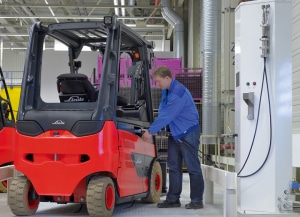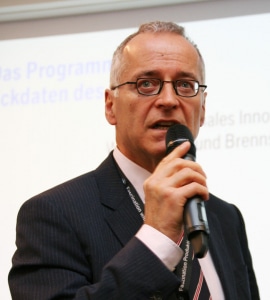The presentation of the results of the H2IntraDrive project was not a sales event or press conference – it was both. On Nov. 23, 2015, the project partners as well as representatives of prospective new partners and some reporters gathered in the BMW factory in Leipzig to take a look at the results of two years of development. The important thing to take away from the event was: Even today, industrial fuel cell vehicles can be commercially viable provided that they meet certain specific requirements.
Robert Mitchell, research assistant from the Institute for Materials Handling, Material Flow, Logistics (fml) at the Technical University of Munich (TUM) revealed the most important information only at the conclusion of the event. In a professionally presented result report, he explained the project approach, evaluation criteria and the ecological aspects before concluding that forklift trucks and tow tractors running on fuel cells can indeed be marketable and “have already been commercially viable today, without the need for subsidies.”The H2IntraDrive project, which received EUR 2.9 million in grants from the National Innovation Programme for Hydrogen and Fuel Cell Technology (NIP) was launched in December 2013 – but first in a test run. Regular operation commenced in 2014. Back then, five forklift trucks (type Linde E35 HL und E25 HL) as well as six tow tractors, all running on pure hydrogen, started their work in the production factory of the BMW Group. Here in Leipzig, where 5,000 employees primarily manufacture innovative units exemplifying the brand image (besides the 2 Series, daily factory output includes 100 i3 as well as 20 i8), the first thing that was installed was an H2 filling station to test the powered industrial trucks in intralogistics. Linde Material Handling (MH) was responsible for developing the power train and retrofitting the vehicles while fml conducted the research.
22,000 hours in operation
The base for the test vehicles were commercially available electric forklift trucks and tow tractors, which were retrofitted for H2IntraDrive and developed further during the project’s run time. For example, two tow tractors were equipped with Fronius fuel cells and four received units from HyPulsion. The forklift trucks were all equipped with HyPulsion units. The hydrogen needed was delivered three times a month from the nearby steam reforming plant of Linde Gas in Leuna. Together, the eleven industrial trucks and tractors soon had 20,000 operational hours behind them. In total, they consumed 4,200 kilograms of hydrogen.
Powered industrial trucks running on fuel cells are regarded as having advantages over battery-driven versions when it comes to ease of use and refill times. For example, there is no need to check the acid level as opposed to batteries equipped. Additionally, fuel cells avoid replacement batteries and long charge times; the same is true for lift equipment, drench showers, etc. A filling station for hydrogen saves quite a lot of space in comparison, and refills are quickly done (station size: 15 m2; see table). The main downside is still the high costs involved – both for the fuel cell systems as well as for their maintenance and the H2 infrastructure.
Table: Time saved through fuel cell use
Forklift truck Tow truck
Battery change approx. 10 min approx. 5 min
H2 refill 2.2 min 1.5 min
Significant knowledge deficit
A big majority of 93% of the all in all 109 industry experts asked by TUM employees in summer 2015 sees clear advantages when using hydrogen engines as opposed to purely battery-driven vehicles. At the same time, however, almost 80% of the respondents felt that they still knew too little about the opportunities of the new technology. Professor Willibald A. Günthner, Chair of fml at the TUM, confirmed: “There is still a significant knowledge deficit.” To close the information gap, the project partners created a Guide on the Use of Hydrogen-Powered Industrial Trucks as well as a comprehensive research report.
Christophe Lautray, CSO of Kion-owned Linde MH, explained: “The project has closed a knowledge gap.” Regarding new prospects who could be interested in using the technology and were invited to the event, Lautray added: “It is an important signal to our customers that during the long-running test, hydrogen has become a tried-and-proven technology as part of the bodywork of the BMW i and is now ready for the mass market.”
No question about it!
Asked by H2-international which technology he would favor, Jens Markert, driver of a forklift truck at BMW replied: “No question about it – fuel cells, since they are easier to operate. I just hop on and start up the truck.”
Evaluating the results
All in all, there have been 16 fuel cell industrial trucks in operation across Germany (eleven at BMW, two at Mercedes, three at Hoppecke). Considering that the NIP granted the segment around EUR 7 million between 2007 and 2015, this corresponds to over EUR 0.4 million per unit. Volkswagen does have around 60 additional units in the pipeline and has submitted its application for NIP subsidies, but the funding hasn’t been confirmed yet.
Across Europe, there were around 63 units in operation in spring 2015, whereas the number of units in the US was around 7,000 back then and is meanwhile approaching 100,000. Wolfgang Axthammer (see figure 2), CEO of NOW, admitted: “To catch up to the competition from abroad, we’ll still have some way to go.”
Asked about why the differences between Europe and the US were so striking, Dr. Michael Ströbel, lead purchaser at BMW, explained: “There were a lot of hurdles to overcome, both in terms of regulations and in terms of the technology.” Notable differences can also be observed concerning the size of the premises: While the factory in Leipzig uses ten to twelve kilograms of hydrogen per day, the BMW facility in Spartanburg in the US consumes eight tons during the same period. It is not only that the number of vehicles is higher in the United States. As the TUM researchers concluded, the work intensity is greater while H2 costs are lower (EUR 3.6 to 5 per kilogram compared to EUR 7 to 8 per kilogram, respectively).
Günthner, W., Micheli, R., Leitfaden für den Einsatz von wasserstoffbetriebenen Flurförderzeugen, TU München, 2015
Other projects
Fuel cells only
In October 2015, French food supplier Prelodis inaugurated a new distribution center near Orleans, where the only powered industrial trucks are fuel cell versions by Jungheinrich. Instead of a charge point, the company installed a hydrogen filling station, so that there are now a total of 35 units by HyPulsion driving on 10,000 m² in Saint-Cyr-en-Val. Prelodis President Philippe Giroux had the following to say about the decision: “Our motivation was the costs we could potentially save, the ease of use that the trucks offered, the space we gained not needing a room for a charge point as well as our enthusiasm to be able to equip a new location with innovative technology.”
200 units for Halle
The supermarket chain Colruyt Group in Belgium has had twelve systems from different manufacturers in operation since the end of 2014 (forklift trucks and order picking units). In two stages, the number of powered industrial trucks in the distribution center in Halle is planned to rise to 200. This includes an initial 75 units by Plug Power and a later delivery of another 125. Project head Jonas Cautaerts explained: “Hydrogen is one of our main means of reducing our environmental impact.”



























0 Comments